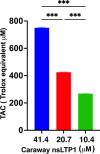The structural characterization and bioactivity assessment of nonspecific lipid transfer protein 1 (nsLTP1) from caraway (Carum carvi) seeds
- PMID: 37474939
- PMCID: PMC10357877
- DOI: 10.1186/s12906-023-04083-9
The structural characterization and bioactivity assessment of nonspecific lipid transfer protein 1 (nsLTP1) from caraway (Carum carvi) seeds
Abstract
Background: Carum carvi (caraway) of the Apiaceae family has been used in many cultures as a cooking spice and part of the folk medicine. Previous reports primarily focus on the medicinal properties of caraway seed essential oil and the whole seeds extract. However, no effort has been made to study caraway proteins and their potential pharmacological properties, including nonspecific lipid transfer protein (nsLTP), necessitating further research. The current study aimed to characterize nonspecific lipid transfer protein 1 (nsLTP1) from caraway seed, determine its three-dimensional structure, and analyze protein-ligand complex interactions through docking studies. We also evaluated nsLTP1 in vitro cytotoxic effect and antioxidant capacity. Additionally, nsLTP1 thermal- and pH- stability were investigated.
Methods: Caraway nsLTP1 was purified using two-dimensional chromatography. The complete amino acid sequence of nsLTP1 was achieved by intact protein sequence for the first 20 residues and the overlapping digested peptides. The three-dimensional structure was predicted using MODELLER. Autodock Vina software was employed for docking fatty acids against caraway nsLTP1. Assessment of nsLTP1 cytotoxic activity was achieved by MTS assay, and the Trolox equivalent antioxidant capacity (TAC) was determined. Thermal and pH stability of the nsLTP1 was examined by circular dichroism (CD) spectroscopy.
Results: Caraway nsLTP1 is composed of 91 residues and weighs 9652 Da. The three-dimensional structure of caraway nsLTP1 sequence was constructed based on searching known structures in the PDB. We chose nsLTP of Solanum melongena (PDB ID: 5TVI) as the modeling template with the highest identity among all other homologous proteins. Docking linolenic acid with caraway protein showed a maximum binding score of -3.6 kcal/mol. A preliminary screening of caraway nsLTP1 suppressed the proliferation of human breast cancer cell lines MDA-MB-231 and MCF-7 in a dose‑dependent manner with an IC50 value of 52.93 and 44.76 μM, respectively. Also, nsLTP1 (41.4 μM) showed TAC up to 750.4 μM Trolox equivalent. Assessment of nsLTP1 demonstrated high thermal/pH stability.
Conclusion: To the best of our knowledge, this is the first study carried out on nsLTP1 from caraway seeds. We hereby report the sequence of nsLTP1 from caraway seeds and its possible interaction with respective fatty acids using in silico approach. Our data indicated that the protein had anticancer and antioxidant activities and was thermally stable.
Keywords: Antioxidant; Caraway; Cytotoxicity; Molecular modeling; Nonspecific lipid transfer protein; Phylogenetic tree.
© 2023. The Author(s).
Conflict of interest statement
The authors declare that they have no competing interests.
Figures









References
-
- World Health Organization . WHO global report on traditional and complementary medicine 2019. Geneva: World Health Organization; 2019.
-
- dos Santos-Silva CA, Zupin L, Oliveira-Lima M, Vilela LMB, Bezerra-Neto JP, Ferreira-Neto JR, et al. Plant Antimicrobial Peptides: State of the Art, In Silico Prediction and Perspectives in the Omics Era. Bioinform Biol Insights. 2020;14:1177932220952739. doi: 10.1177/1177932220952739. - DOI - PMC - PubMed
MeSH terms
Substances
LinkOut - more resources
Full Text Sources
Research Materials
Miscellaneous

